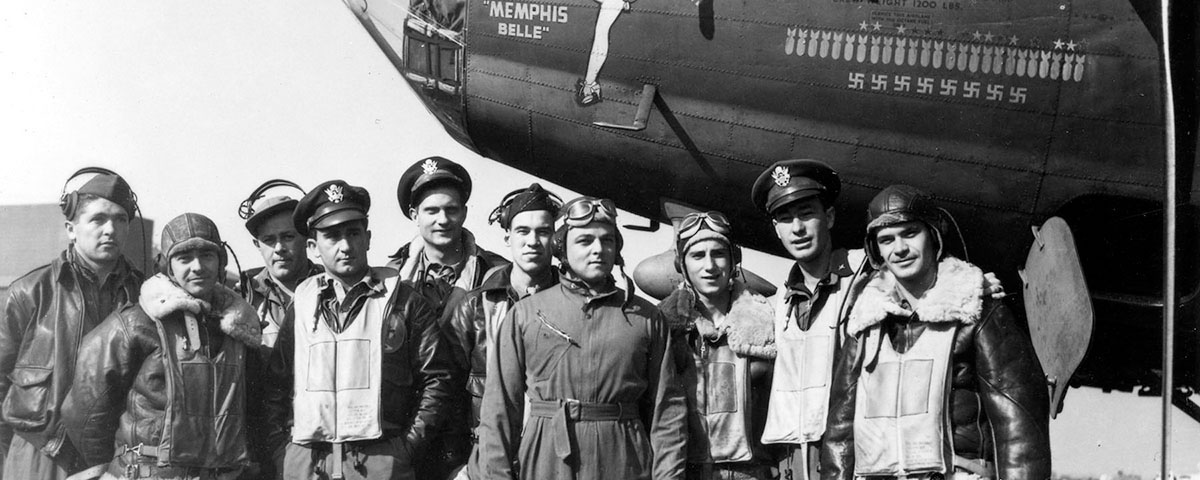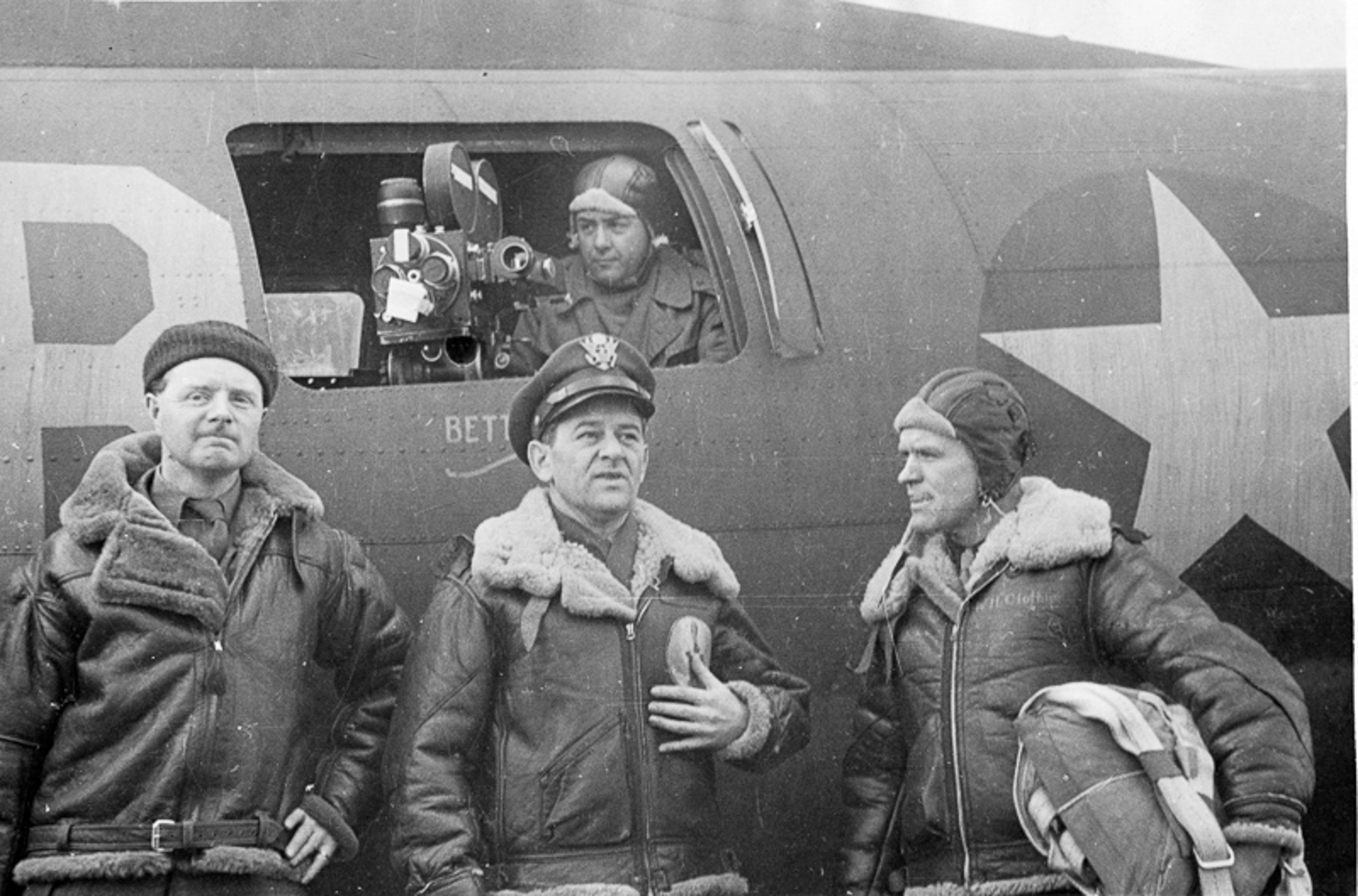

THE MEMPHIS BELLE: A Story of a Flying Fortress (1944)
I recently had the privilege of watching the 2018 restored print of William Wyler’s 1944 film of the twenty-fifth and final bombing mission of a B-17, the ‘Memphis Belle’, as it participated in a raid on the U-boat pens at Wilhelmshaven, Germany. This documentary runs for only forty-three minutes but it is a brilliant example of how a war film (during war-time) can be presented minus any flag-waving or patriotic clap-trap. The Memphis Belle is a solid, no-nonsense representation of the issues that faced the young men who risked their lives in the face of horrendous odds against their survival in mission after mission.
The overall effectiveness of high altitude bombing (B-17s delivered their payloads from 25,000 feet (5 miles) above their targets), has long been disputed, but the courage of those young men who participated has never been in question. They did what they were ordered to do and, by war’s end, 28,000 of them had paid the ultimate price for doing their jobs. To successfully complete twenty-five missions was quite an achievement. The ‘Memphis Belle’ needed to complete the Wilhelmshaven raid and return to base safely in order for its crew of ten to be transferred stateside for a publicity tour designed to promote the importance of the bombing programme.
William Wyler (centre) & his camera crew 1943
Hollywood director William Wyler and his cameramen were placed aboard the aircraft and given permission to film the mission from beginning to end. Wyler himself was adamant that neither he nor his camera crew be acknowledged in the credits at the time. This was, after all, he said, to be a record of the crew of the aircraft on their twenty-fifth mission. Wyler and his people were merely along as witnesses. The 2018 restoration, however, listed the director and his camera crew. And rightly so. They deserved the accolades showered on the extraordinary slice of history they had recorded for posterity. Since then a number of facts have emerged, however. For example, it appears that the ‘Memphis Belle’ only flew 21 missions with its now famous crew. The other four missions were added from the crew’s personal combat records aboard other aircraft to bring the number to 25.

The crew of the original ‘Memphis Belle’ 1943
This film is supposed to be a chronicle of the first American bomber to complete 25 missions in WW2, but that is actually incorrect. A B-24 Liberator nicknamed ‘Hot Stuff’ beat the ‘Memphis Belle’ to it, when it completed its qualifying mission on February 7, 1943. The ‘Memphis Belle’ did not complete its final mission until May 19, 1943, a full three months later. Indeed, the ‘Memphis Belle’ was not even the first of the flying fortresses to reach the magical twenty-five missions intact. A B-17 named ‘Delta Rebel II’ made it home after the requisite number of missions on May 1, 1943. Furthermore, there are indications that a B-17 nicknamed ‘Hell’s Angels’ also completed 25 missions one week before the ‘Memphis Belle’! Obviously, it had been necessary to select a potential 25-mission aircraft in advance and prepare it for filming. ‘Memphis Belle’ drew the lucky straw.
The documentary was shot in colour and with sound. It gives us a first-hand look at how frightening and hair-raising it was for crew members to be exposed to flak and fighter attack throughout each mission. Survival often came down to blind luck as we chillingly witness footage of hapless B-17s spiralling out of control after being hit. Little surprise that at least one of the crew of ‘Memphis Belle’ joyfully kissed the ground on the aircraft’s arrival back in Britain. Not only had these young men survived, they could now go home to the United States. Before that could happen, however, they must be decorated for their achievements. Equally exciting (for some of them) was the visit to their base by the King and Queen of England. The royal couple was introduced to each crew member (and their ground crew) on the tarmac as they lined up alongside the ‘Memphis Belle’.

The crew being presented to King George VI & Queen Elizabeth 1943
The aircraft itself was eventually moved (in 2005) to the National Museum of the United States Air Force at Wright-Patterson Air Force Base, Dayton, Ohio, to undergo a multi-year restoration process. It was finally placed on public display in May 2018. Incidentally, the pilot of the B-17, Robert Morgan, named his plane after his girlfriend at the time, Margaret Polk, of Memphis, Tennessee. The couple broke off their engagement soon after Morgan’s return to the US, although they remained lifelong friends. The craft’s nose artwork came from a 1941 illustration in ‘Esquire’ magazine by famous pin-up artist George Petty. Morgan contacted him and requested a pin-up drawing of the girl which Petty supplied from the April ’41 issue of Esquire. The pin-up wears a blue outfit on the port side of the aircraft and a red one on the starboard side. The 91st Air Group’s artist, Tony Starcer, copied it onto the aircraft’s fuselage. Then he added eight swastikas, one for each Nazi aircraft claimed shot down by the crew’s gunners.

The ‘Memphis Belle’ today
In 1990, Warner Brothers released a feature film titled Memphis Belle, starring a whole crop of young, up-and-coming Hollywood actors. The picture was loosely based on the February 1943 mission, but with numerous embellishments intended to further dramatize the moment. The names of all ten crew members were changed to fictitious ones. In fact, about the only close adherence to fact was the choice of youngsters to portray the crew. USAAF bomber crews during the battle were indeed very young men. An indication of just how tough it was to get through twenty-five missions is best demonstrated by the repairs the ‘Memphis Belle’ underwent over a period of just six months. The aircraft’s crew chief, Pennsylvanian Joe Giambrone, listed the main repairs his crew carried out in that time: Nine engines had to be replaced, both wings, the tail (twice) and both landing gear assemblies. And that did not include minor patching up work. A B-17 nicknamed ‘The Sally B’, the last airworthy flying fortress in the United Kingdom, portrayed the ‘Belle’ in the film.


Really interesting post, Alan. Every day is a school day. Respect to all the young air crews of WW2.
Hi, Cat. Lovely to hear from you. I was beginning to worry that COVID might have nailed you!
Still here and Vivid free, Alan! Enjoying posts as ever.
That’s good to hear, Cat. Stay healthy.
Nice article. Those bombing missions were extremely perilous. If, on average 5% of the planes on a mission did not return safely, the chance of making it through 25 missions is only slightly better than one in four; if the loss rate is as high as 10%, then the chance of survival is only 7%. Either way, not great.
Thankyou, Dan. The high casualty rate came about, of course, because the Americans carried out the daylight raids. The Royal Air Force’s Bomber Command flew the night-time attacks. Either way, it was a dangerous occupation manning a bomber in WW2.
Thanks to you, Alan, from our friendly continent across the sea, for teaching me more than I ever knew about not only about the Memphis Belle but a large portion of WW2. Really fascinating. I thank you.
In reading more about B-17s (more than 20,000 of them built up in Seattle), I notice that the talented American actess Swoosie Kurtz got her unusual name from the B-17 her father piloted. “The Swoose,” rhymes with goose.
Again, thank you. Well done today!
I have actually sat in the pilot’s seat of the B17 used in the picture, Dan It was at Warner World in Queensland and they selected visitors to re-enact a scene. The buggars picked me! I suppose it could have been worse because some poor bloke had to don Superman tights and pretend to fly! I only had to put on a pilot’s cap and speak a line of dialogue (very badly I might add), but it was exciting to climb aboard a real bomber, one that had actually gone on wartime raids.